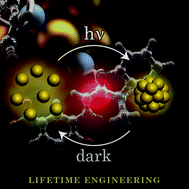Controlling the lifetimes of dynamic nanoparticle aggregates by spiropyran functionalization†
Abstract
Novel light-responsive nanoparticles were synthesized by decorating the surfaces of gold and silver nanoparticles with a nitrospiropyran molecular photoswitch. Upon exposure to UV light in nonpolar solvents, these nanoparticles self-assembled to afford spherical aggregates, which disassembled rapidly when the UV stimulus was turned off. The sizes of these aggregates depended on the nanoparticle concentration, and their lifetimes could be controlled by adjusting the surface concentration of nitrospiropyran on the nanoparticles. The conformational flexibility of nitrospiropyran, which was altered by modifying the structure of the background ligand, had a profound impact on the self-assembly process. By coating the nanoparticles with a spiropyran lacking the nitro group, a conceptually different self-assembly system, relying on a reversible proton transfer, was realized. The resulting particles spontaneously (in the dark) assembled into aggregates that could be readily disassembled upon exposure to blue light.


 Please wait while we load your content...
Please wait while we load your content...